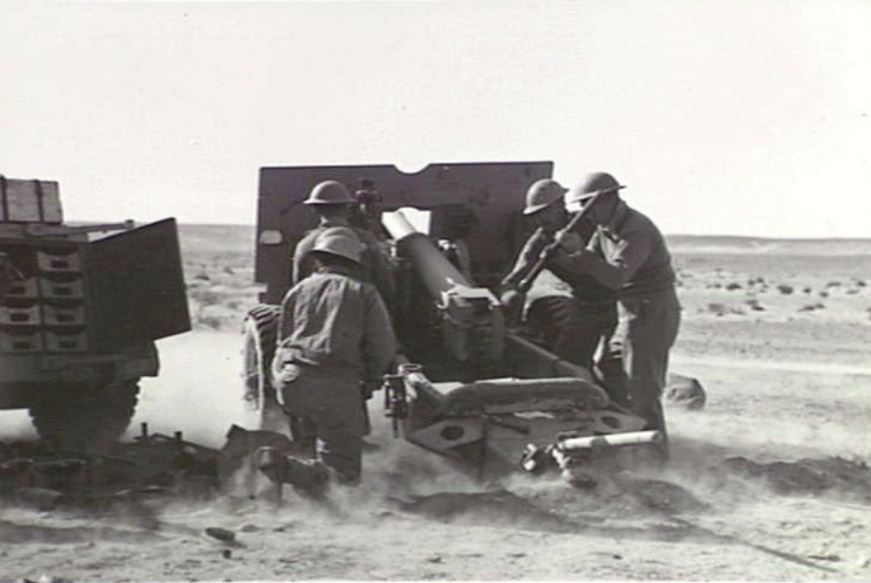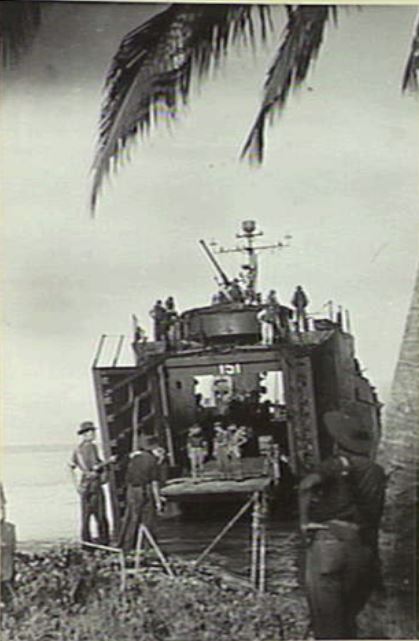2/7th Australian Field Regiment
From Our Contribution
 25 Pounder of he 2/7th Field Regiment AWM photo 023076 | |
 30 Apr 1945. The 2/7th Field regiment's 25 Pounders landing on Sadau Island. AWM photo 090864 |
Contents
Brief History
The 2/7th Australian Field Regiment was formed during April 1940 with recruits coming from the militia artillery brigades in South and Western Australia. The first South Australians came from the 13th Field Brigade and formed the 13th Battery at Woodside. The first group of Western Australians came from the 3rd Field Brigade and formed the 14th Battery at Northam. In October they were allotted to the 9th Division. The division's other artillery regiments were the 2/8th and 2/12th Field Regiments. Later, in October 1941, when the regiment was in the Middle East, a third battery, the 57th Battery was formed. On 17 Nov 1941 the 13th Battery sailed from Port Adelaide's Outer Harbour, where it joined the 2/48th Battalion and other auxiliary units, aboard the troopship SS Stratheden. The Stratheden reached Fremantle four days later, where 14th Battery embarked on 22 November. The Stratheden reached the harbour at Kantara, on the edge of the Sinai, and the regiment travelled by train to Palestine, going into camp at Qastina. It remained in Palestine for four months, training with 18-pounder guns and 4.5-inch howitzers.
In March 1941 the 9th Division was sent from Palestine to Libya to garrison the area east of Tobruk, but the division did not have enough vehicles to take all its units forward. In April the 2/7th Field Regiment moved to Ikingi Marut, Egypt, and in May to Mersa Matruh, where it received most of its 25-pounders at the end of July. After three months at Matruh, the 2/7th moved closer to the front, taking up a position between Halfaya Pass, controlled by German and Italian troops, and Sidi Barrani, which was being developed into a fortress by British Commonwealth troops, in the Coastal Sector. The gunners remained in the western desert until October. By this time nearly all Australian troops had been evacuated from Tobruk and the 9th Division was reforming in Palestine. The 2/7th, however, was sent to the Royal Artillery's Almaza Base Depot, Cairo, where it became the depot training regiment at the Middle East School of Artillery. In early 1942 the 9th Division moved to Syria, and in February the 2/7th took over defensive positions at Bsarma, near Tripoli, from the 2/5th Field Regiment.
By June the German and Italian forces had reached El Alamein, in Egypt, about 112 kilometres west of Alexandria. The Australian 9th Division was rushed to the Alamein "box" and held the northern sector for almost four months. The regiment reached the Alamein front in July and under the command of the 9th Division's 26th Brigade, took up position at Kilo 91, east of El Alamein, on 8 July before going into action two days later. On 10 July, attacking inland from the coast, the 26th Brigade attacked the German positions at Tel el Eisa. The attack was supported by all three of the division's artillery regiments, with the 2/7th being involved in the heavy fighting that followed when the Germans counter-attacked. Fighting continued for five days, during which time the 2/7th fired 20,129 rounds.
The 2/7th remained in action during the following months, supporting Operation Bulimba, the 20th Brigade's attack at the start of September. During the main Alamein offensive at the end of October and the start of November, the 2/7th supported the 20th Brigade's advance. During the 13 days of battle, the regiment fired 65,594 rounds of high-explosive shells. Once the breakthrough occurred, the regiment participated in the pursuit of enemy troops and went as far as El Daba about 180 kilometers west of Alexandria. However, the 9th Division was now needed elsewhere, and began returning to Australia in January 1943. The 2/7th arrived in Fremantle on 18 Feb 1943 and in Melbourne a week later. The regiment was given leave before moving to Queensland in April.
The gunners spent the next two years in north Australia, training first at Kiri and then Ravenshoe, on the Atherton Tablelands. The war was almost over before the regiment again went into action. In April 1945 the division was transported to Morotai, which was being used as a staging area for the Oboe operations on Borneo. The first phase of the Borneo operation was an amphibious landing on Tarakan Island by the 26th Brigade and the 2/7th Field Regiment participated in this action. Going ashore in landing craft, the followed the infantry, landing on Tarakan on 1 May. Preceding the invasion, five guns from the regiment's 57th Battery had landed on Sadau Island to help cover the landing. The regiment was frequently called upon to give artillery support, shelling heavily defended Japanese positions. The regiment fired more than 37,000 shells during the campaign.
Following Japan's surrender and the end of the war, the regiment's ranks thinned as men were discharged or transferred. The last members of the unit left Tarakan in December and the 2/7th Field Regiment was disbanded in January 1946. Forty Seven men lost their lives while serving with this unit.
Regiment Personnel
Individual Honours
- 3 x Distinguished Service Order
- 1 x Military Cross
- 4 x Military Medal
- 2 x Mentioned in Despatches
Notes
Information has come from the Australian War Memorial website [1] accessed 6 Feb 2021.